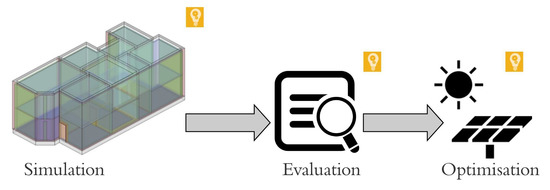Evaluating Design Strategies for Nearly Zero Energy Buildings in the Middle East and North Africa Regions
Abstract
1. Introduction
2. Materials and Methods
2.1. Current Building Definitions and Standards for nZEB
- Net Zero Site Energy: A ZEB site produces at least as much energy as it uses in a year, when accounted for at the site.
- Net Zero Source Energy: A ZEB source produces at least as much energy as it uses in a year, when accounted for at the source. Source energy refers to the primary energy used to generate and deliver the energy to the site. To calculate a building’s total source energy, imported and exported energy is multiplied by the appropriate site-to-source conversion multipliers.
- Net Zero Energy Costs: In a ZEB cost, the amount of money the utility pays the building owner for the energy the building exports to the grid is at least equal to the amount the owner pays the utility for the energy services and energy used over the year.
- Net Zero Energy Emissions: A net-zero emissions building produces at least as much emissions-free renewable energy as it uses from emissions-producing energy sources.
2.2. Methodology
2.3. Potential Solutions to Achieve nZEB
- Building envelope: Wall construction solutions that were available for the simulation are: uninsulated, R13 metal, 14-inch insulated concrete form.
- Windows to wall ratios (WWR): The percentage of the openings area are defined based on location of walls on the western, eastern, southern, and northern facade of the building. The percentage of the openings varies from 0% with no openings to 95% of openings.
- Windows glass type: Multiple options considered for glazing types and these are single-pane glazing, double-pane glazing, and triple-pane glazing.
- Photovoltaics efficiency, coverage area, and payback period: the options considered under this group are: 16%, 18.6%, and 20.4% efficiencies. The PV coverage areas considered are 60% moderate range to 90% high range. Payback periods range from 10 to 30 years.
- HVAC system: the options that are available within this group includes Association of Heating, Ventilation, and Refrigeration engineers (ASHRAE) Heat Pump, Split Air conditioning, and High Package Terminal AC.
- Appliances efficiency: the options within this category varies from 27.9 W/m2 for inefficient appliances to 6.46 W/m2 for high-efficiency appliances.
- Lighting efficiency: the lighting ranges from 20.45 W/m2 for inefficient lighting to 3.2 W/m2 for very efficient lighting.
- Air Infiltration: the options ranges between 0.17–2 air changes per hour (ACH) air leakage.
- Operation schedule and daylighting, and occupancy control: the hours that represent the time of running appliances, HVAC, and lighting. These vary from 24/7 to 12/5 hours/days per week.
- Roof Construction: options ranges from uninsulated roof to insulated roof with 10.25-inch SIP insulation system.
3. Results of the Simulation
3.1. Improving the Current Building Standards
3.2. Further Improvements to Achieve Positive Energy Buildings
4. Conclusions
Author Contributions
Funding
Conflicts of Interest
Abbreviations
| MENA | Middle East and North Africa |
| ZEB | Zero Energy Buildings |
| nZEB | Nearly Zero Energy Buildings |
| PV | Solar Photovoltaic |
| BIM | Building Information Modelling |
| GBS | Green Building Studio |
| HDD | Heating Degree Days |
| CDD | Cooling Degree days |
| HVAC | Heating, Ventilation, and Air-conditioning |
| SIP | Structural Insulated Panel |
| ACH | Air Changes Per Hour |
| IES-VE | Integrated Environmental Solution–Virtual Environment |
| ASHRAE | Association of Heating, Ventilation, and Refrigeration Engineers |
| WWR | Windows to Wall Ratio |
| ICF | Insulated Concrete Formwork |
| U-value | Thermal Transmittance |
References
- Yang, L.; Yan, H.; Lam, J.C. Thermal comfort and building energy consumption implications—A review. Appl. Energy 2014, 115, 164–173. [Google Scholar] [CrossRef]
- IEA Buildings. Available online: https://www.iea.org/buildings/ (accessed on 1 September 2018).
- SIEMENS Middle East Power outlook 2035. Available online: https://www.siemens.com/content/dam/webassetpool/mam/tag-siemens-com/smdb/regions/mea/middle-east-power-outlook-2035.pdf (accessed on 17 April 2018).
- IMF Energy Subsidies in the Middle East and North Africa: Lessons for Reform. Available online: https://www.imf.org/external/np/fad/subsidies/pdf/menanote.pdf (accessed on 17 April 2018).
- Zhang, X.P.; Ou, M.; Song, Y.; Li, X. Review of Middle East energy interconnection development. J. Mod. Power Syst. Clean Energy 2017, 5, 917–935. [Google Scholar] [CrossRef]
- RCREEE Arab future energy index 1015–Energy efficiency. Available online: http://www.rcreee.org/projects/arab-future-energy-indexTM-afex (accessed on 17 April 2018).
- Brumana, G.; Franchini, G.; Perdichizzi, A. Design and Performance Prediction of an Energy+ Building in Dubai. Energy Procedia 2017, 126, 155–162. [Google Scholar] [CrossRef]
- Krarti, M.; Ihm, P. Evaluation of net-zero energy residential buildings in the MENA region. Sustain. Cities Soc. 2016, 22, 116–125. [Google Scholar] [CrossRef]
- Aldossary, N.A.; Rezgui, Y.; Kwan, A. Establishing domestic low energy consumption reference levels for Saudi Arabia and the Wider Middle Eastern Region. Sustain. Cities Soc. 2017, 28, 265–276. [Google Scholar] [CrossRef]
- Alrashed, F.; Asif, M. Analysis of critical climate related factors for the application of zero-energy homes in Saudi Arabia. Renew. Sustain. Energy Rev. 2015, 41, 1395–1403. [Google Scholar] [CrossRef]
- Zacà, I.; D’Agostino, D.; Maria Congedo, P.; Baglivo, C. Data of cost-optimality and technical solutions for high energy performance buildings in warm climate. Data Br. 2015, 4, 222–225. [Google Scholar] [CrossRef] [PubMed]
- Congedo, P.M.; Baglivo, C.; Zacà, I.; D’Agostino, D. High performance solutions and data for nZEBs offices located in warm climates. Data Br. 2015, 5, 502–505. [Google Scholar] [CrossRef] [PubMed]
- Congedo, P.M.; Baglivo, C.; D’Agostino, D.; Zacà, I. Cost-optimal design for nearly zero energy office buildings located in warm climates. Energy 2015, 91, 967–982. [Google Scholar] [CrossRef]
- Zacà, I.; D’Agostino, D.; Congedo, P.M.; Baglivo, C. Assessment of cost-optimality and technical solutions in high performance multi-residential buildings in the Mediterranean area. Energy Build. 2015, 102, 250–265. [Google Scholar] [CrossRef]
- Torcellini, P.; Pless, S.; Deru, M. Zero Energy Buildings: A Critical Look at the Definition Preprint. ACEE Summer studay 2006. [Google Scholar] [CrossRef]
- Crawley, D.; Pless, S.; Torcellini, P. Getting to Net Zero; National Renewable Energy Laboratory: Golden, CO, USA, 2010.
- Hernandez, P.; Kenny, P. From net energy to zero energy buildings: Defining life cycle zero energy buildings (LC-ZEB). Energy Build. 2010, 42, 815–821. [Google Scholar] [CrossRef]
- Sesana, M.M.; Salvalai, G. Overview on life cycle methodologies and economic feasibility fornZEBs. Build. Environ. 2013, 67, 211–216. [Google Scholar] [CrossRef]
- European Comission Nearly Zero-energy buidlings. Available online: https://ec.europa.eu/energy/en/topics/energy-efficiency/buildings/nearly-zero-energy-buildings (accessed on 17 April 2018).
- Staffell, I.; Pfenninger, S. The increasing impact of weather on electricity supply and demand. Energy 2018, 145, 65–78. [Google Scholar] [CrossRef]
- BPIE nZEB definitions across Europe. Available online: http://bpie.eu/publication/nzeb-definitions-across-europe-2015/ (accessed on 17 April 2018).
- SEFAIRA Six Metrics Every Architect Should Know (And How to Use Them). Available online: http://sefaira.com/resources/six-metrics-every-architect-should-know-and-how-to-use-them/ (accessed on 17 April 2018).
- ZEBRA2020 Data Tools. Available online: http://www.zebra-monitoring.enerdata.eu/nzeb-activities/panel-distribution.html (accessed on 9 September 2018).
- European Commission Nearly zero-energy buildings. Available online: https://ec.europa.eu/energy/en/topics/energy-efficiency/buildings/nearly-zero-energy-buildings (accessed on 1 December 2017).
- Zhao, H.X.; Magoulès, F. A review on the prediction of building energy consumption. Renew. Sustain. Energy Rev. 2012, 16, 3586–3592. [Google Scholar] [CrossRef]
- Mwasha, A.; Williams, R.G.; Iwaro, J. Modeling the performance of residential building envelope: The role of sustainable energy performance indicators. Energy Build. 2011, 43, 2108–2117. [Google Scholar] [CrossRef]
- Zero Carbon Hub. CLOSING THE GAP BETWEEN DESIGN AND AS-BUILT PERFORMANCE. Available online: http://www.zerocarbonhub.org/sites/default/files/resources/reports/Closing_the_Gap_Bewteen_Design_and_As-Built_Performance_Interim_Report.pdf (accessed on 16 September 2018).
- Gerrish, T.; Ruikar, K.; Cook, M.; Johnson, M.; Phillip, M.; Lowry, C. BIM application to building energy performance visualisation and management: Challenges and potential. Energy Build. 2017, 144, 218–228. [Google Scholar] [CrossRef]
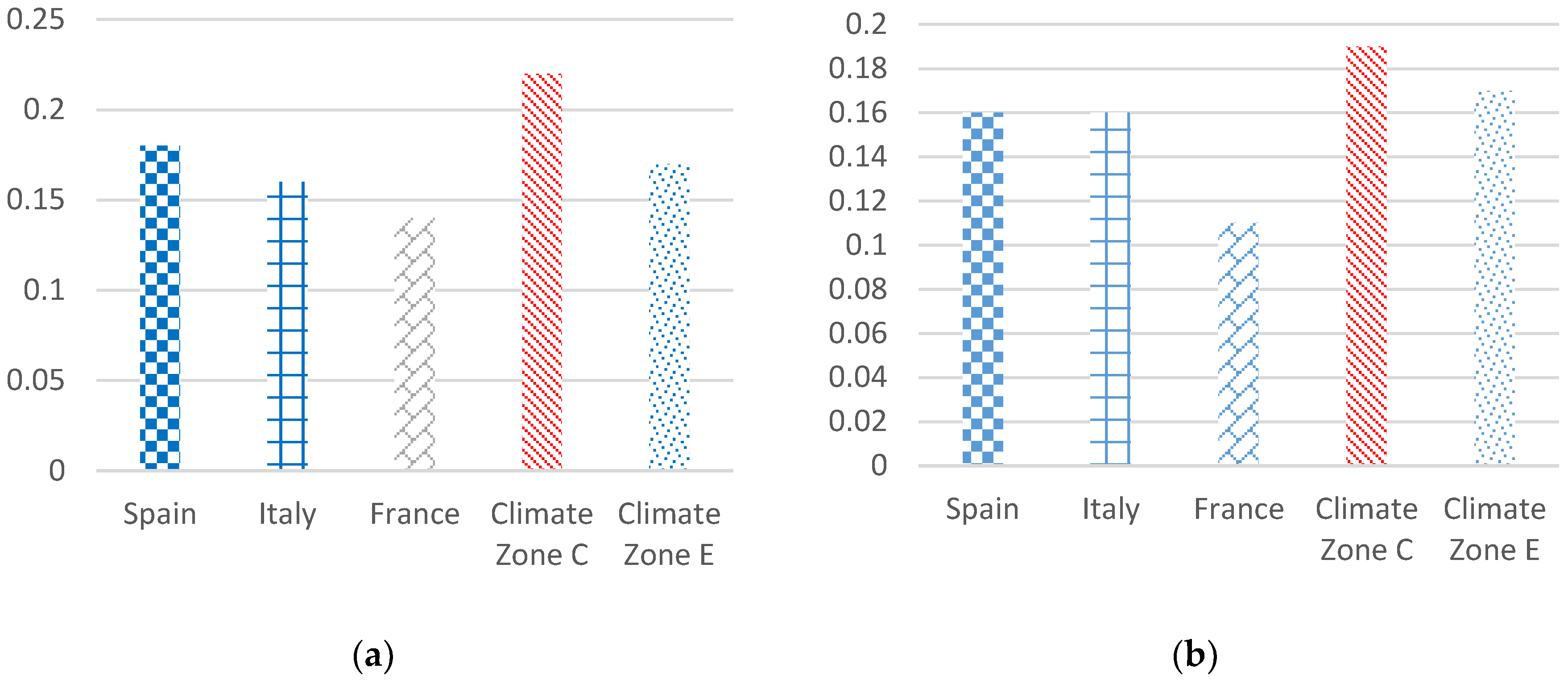
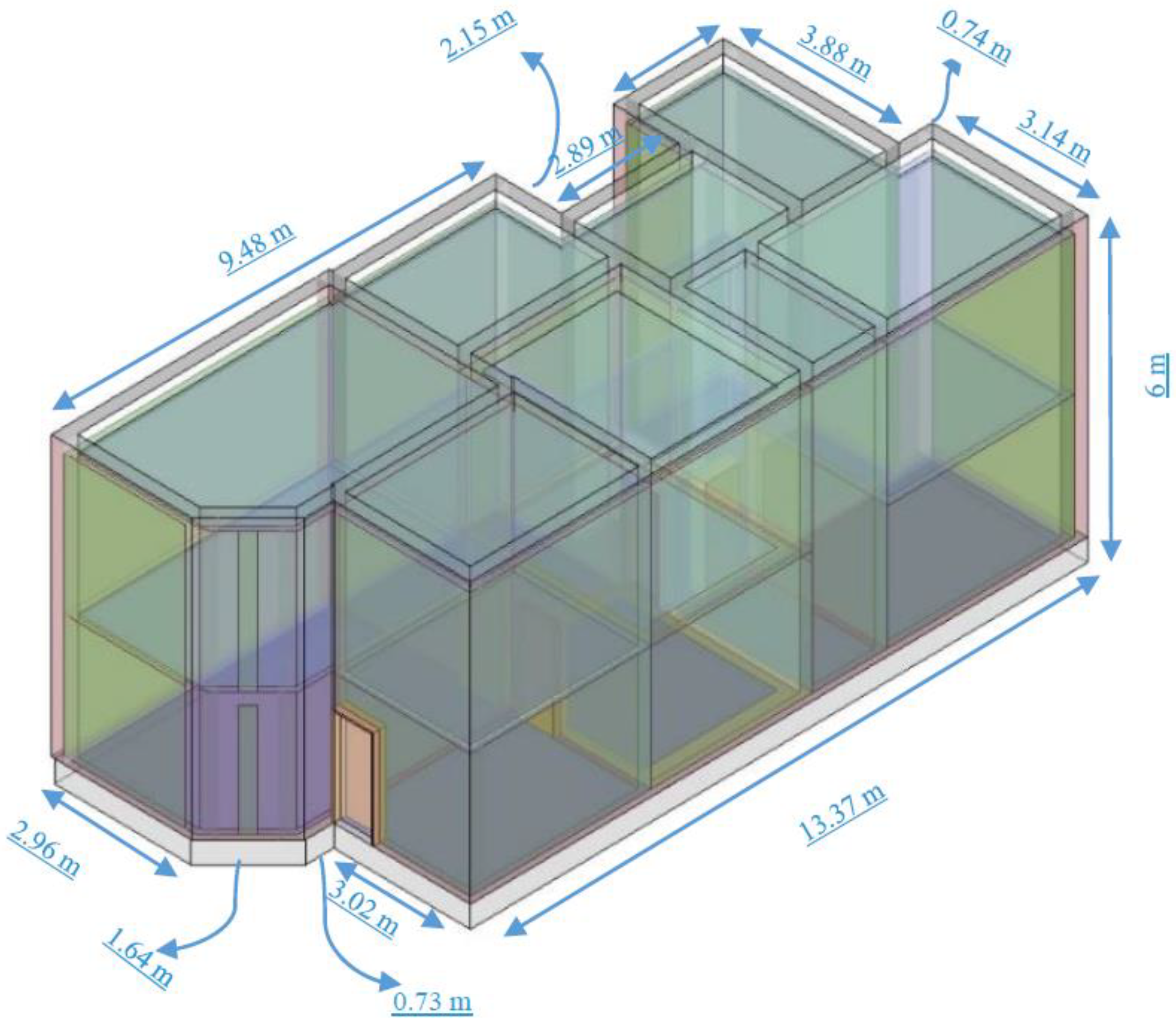
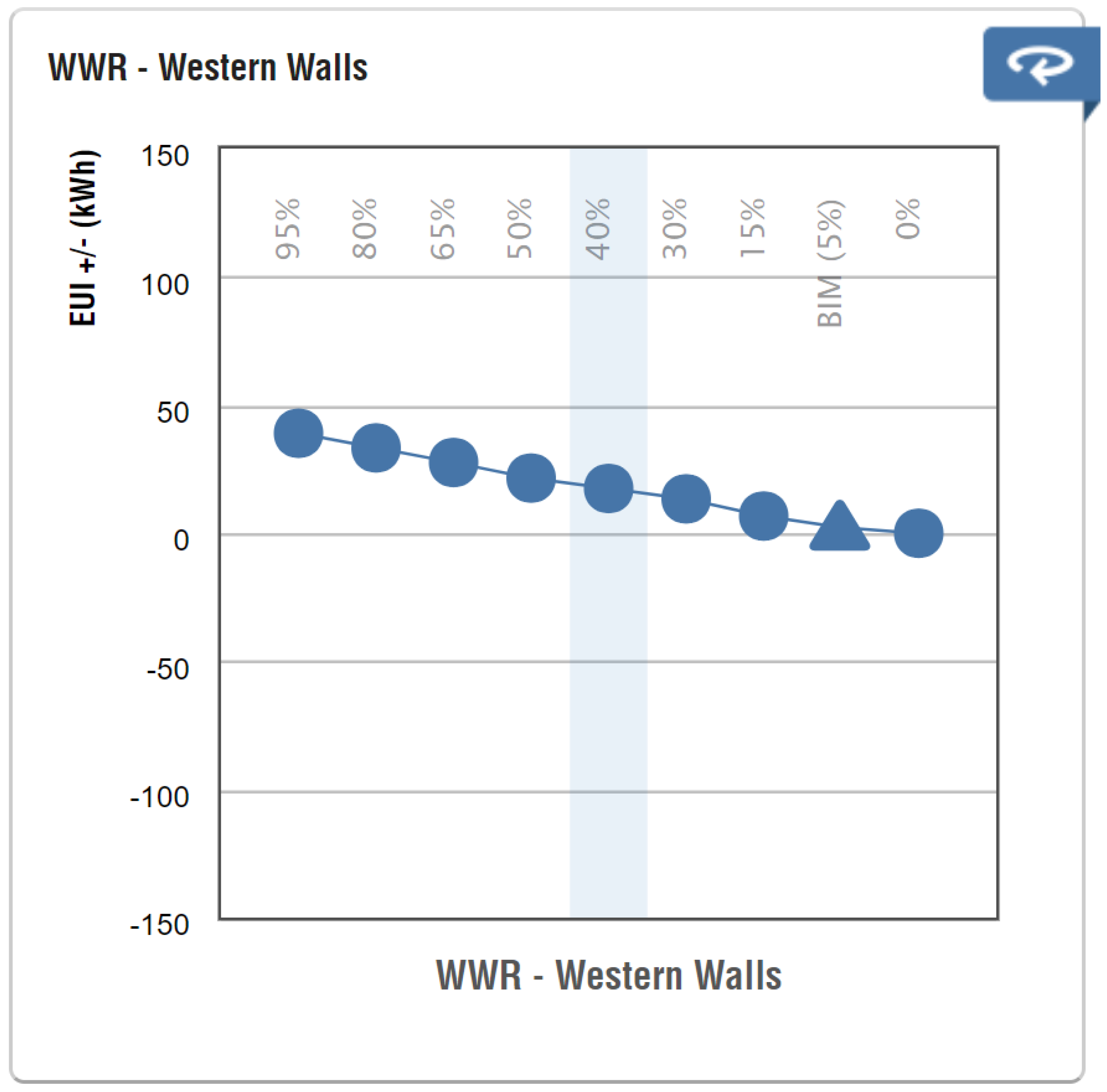
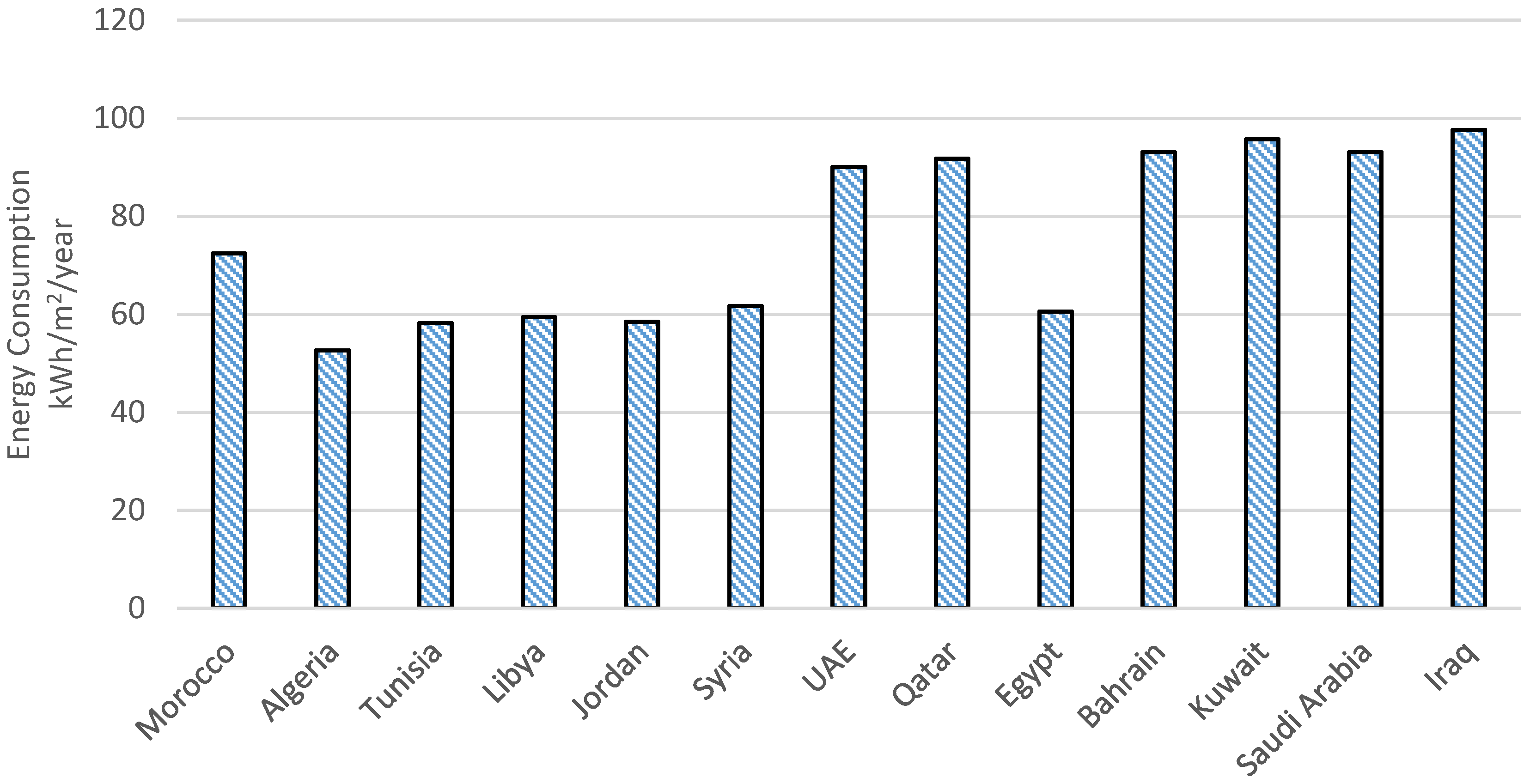

| Countries | nZEB Definitions a | Average kWh/m2/year b | Average kWh/m2/year c |
|---|---|---|---|
| Croatia | 33.40 kWh/m2/year | 62.79 | 15.9 |
| Cyprus | Not defined | 100 | Not defined |
| France | 50 kWh/m2/year | 50 | 67.2 |
| Italy | Not defined | 20.40 | 15.9 |
| Malta | 40 kWh/m2/year | 40 | Not defined |
| Spain | Not defined | Not defined | 87.3 |
| Building Characteristic | Description |
|---|---|
| HVAC System | Residential 17 SEER split unit |
| Roof | 12-inch heavyweight concrete (U = 3.12 W/m2·K) |
| Wall | 6-inch heavyweight concrete (U = 0.6819 W/m2·K) |
| Window | ¼ inch single glass pane in heavy frame (U = 3.195 W/m2·K) |
| Air Infiltration | 2 ACH |
| Lighting | 10 W/m2·K |
| Building Orientation | 0° (North) |
| Window Wall Ratio For Southern Wall and Eastern Wall | 20% |
| Window Wall Ratio for Northern Wall | 40% |
| Glazing Type | Single glazing for all windows |
| Shading Type | No shading applied for all windows |
| Countries | HDD | CDD |
|---|---|---|
| Iraq | 800 | 2400 |
| Syria | 1200 | 1600 |
| Jordan | 1000 | 1200 |
| Kuwait | 400 | 3200 |
| Saudi Arabia | 400 | 3200 |
| Qatar | 200 | 3600 |
| Bahrain | 200 | 3600 |
| UAE | 200 | 3600 |
| Oman | 100 | 3600 |
| Egypt | 400 | 1600 |
| Libya | 400 | 2000 |
| Tunisia | 600 | 1000 |
| Algeria | 1400 | 1600 |
| Morocco | 1000 | 1600 |
| Country | Result with No Improvement kWh/m2/year | ASHRAE 90.1 kWh/m2/year |
|---|---|---|
| Iraq | 229 | 119 |
| Syria | 236 | 156 |
| Jordan | 229 | 131 |
| Kuwait | 276 | 100 |
| Saudi Arabia | 274 | 100 |
| Qatar | 283 | 93 |
| Bahrain | 281 | 87 |
| United Arab Emirates | 285 | 87 |
| Oman | 278 | 82 |
| Egypt | 262 | 107 |
| Libya | 259 | 108 |
| Tunisia | 252 | 107 |
| Algeria | 274 | 108 |
| Morocco | 261 | 230 |
© 2018 by the authors. Licensee MDPI, Basel, Switzerland. This article is an open access article distributed under the terms and conditions of the Creative Commons Attribution (CC BY) license (http://creativecommons.org/licenses/by/4.0/).
Share and Cite
Al-Saeed, Y.W.; Ahmed, A. Evaluating Design Strategies for Nearly Zero Energy Buildings in the Middle East and North Africa Regions. Designs 2018, 2, 35. https://doi.org/10.3390/designs2040035
Al-Saeed YW, Ahmed A. Evaluating Design Strategies for Nearly Zero Energy Buildings in the Middle East and North Africa Regions. Designs. 2018; 2(4):35. https://doi.org/10.3390/designs2040035
Chicago/Turabian StyleAl-Saeed, Yahya Wisam, and Abdullahi Ahmed. 2018. "Evaluating Design Strategies for Nearly Zero Energy Buildings in the Middle East and North Africa Regions" Designs 2, no. 4: 35. https://doi.org/10.3390/designs2040035
APA StyleAl-Saeed, Y. W., & Ahmed, A. (2018). Evaluating Design Strategies for Nearly Zero Energy Buildings in the Middle East and North Africa Regions. Designs, 2(4), 35. https://doi.org/10.3390/designs2040035



